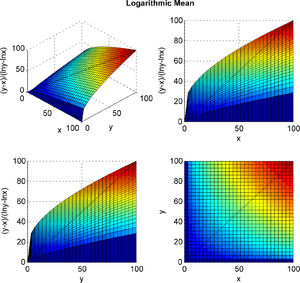Logarithmic mean

In mathematics, the logarithmic mean is a function of two non-negative numbers which is equal to their difference divided by the logarithm of their quotient. In symbols:
for the positive numbers . This calculation is applicable in engineering problems involving heat and mass transfer.
Inequalities
The logarithmic mean of two numbers is smaller than the arithmetic mean but larger than the geometric mean (unless the numbers are the same, in which case all three means are equal to the numbers):
Derivation of the mean
Mean value theorem of differential calculus
From the mean value theorem
the logarithmic mean is obtained as the value of by substituting for
and solving for .
Integration
The logarithmic mean can also be interpreted as the area under an exponential curve.
The area interpretation allows the easy derivation of some basic properties of the logarithmic mean. Since the exponential function is monotonic, the integral over an interval of length 1 is bounded by and . The Homogeneity of the integral operator is transferred to the mean operator, that is .
Generalization
Mean value theorem of differential calculus
You can generalize the mean to variables by considering the mean value theorem for divided differences for the th derivative of the logarithm. You obtain
where denotes a divided difference of the logarithm.
For this leads to
- .
Integral
The integral interpretation can also be generalized to more variables, but it leads to a different result. Given the simplex with and an appropriate measure which assigns the simplex a volume of 1, we obtain
This can be simplified using divided differences of the exponential function to
- .
Example
- .
Connection to other means
See also
- A different mean which is related to logarithms is the geometric mean.
- The logarithmic mean is a special case of the Stolarsky mean.
- Logarithmic mean temperature difference
References
- ↑ B. C. Carlson (1966). "Some inequalities for hypergeometric functions". Proc. Amer. Math. Soc. 17: pp. 32–39. doi:10.1090/s0002-9939-1966-0188497-6.
- ↑ B. Ostle and H. L. Terwilliger (1957). "A comparison of two means". Proc. Montana Acad. Sci. 17: pp. 69–70.
- Logarithmic mean @ Everything2.com
- Oilfield Glossary: Term 'logarithmic mean'
- Weisstein, Eric W. "Arithmetic-Logarithmic-Geometric-Mean Inequality". MathWorld.
- Stolarsky, Kenneth B.: Generalizations of the logarithmic mean, Mathematics Magazine, Vol. 48, No. 2, Mar., 1975, pp 87–92